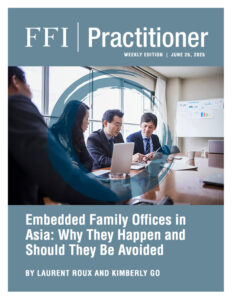
View this edition in our enhanced digital edition format with supporting visual insight and information.
In this week’s FFI Practitioner, FFI Asian Circle Virtual Study Group members Laurent Roux and Kimberly Go discuss embedded family offices—what they are, how they became prevalent among Asian enterprise families, and their risks. Roux and Go also provide questions for family enterprise advisors to consider when and whether a client family might transition from an informal, embedded family office to a formal family office.
A first-generation founder from Hong Kong meets with the family business advisor at a large private bank, eager to grow and manage his wealth. “What do you hope to achieve?” the advisor asks. With the rising buzz around family offices, the founder responds, “I want to start a family office.”
Upon reviewing the founder’s current financial practices, the advisor notices signs of commingling: the chief financial officer is managing the founder’s private accounts, business funds finance family vacations, and the business’s offices and staff are used for the next generation’s new ventures. The advisor returns with an insight: “You already have something like a family office—just in an embedded form.”
Between 2023 and 2030, ultra-high-net-worth (UHNW) and high-net-worth (HNW) families in the Asia–Pacific are expected to undergo an intergenerational wealth transfer totaling $5.8 trillion, according to McKinsey.1 UHNW families alone will account for 60 percent of this shift. In response, many are establishing formal family offices, particularly in hubs like Hong Kong and Singapore, where single-family offices have quadrupled since 2020 to around 4,000.2 However, in reality, many families looking to establish such offices already have an informal structure for managing wealth—what is known as an embedded family office.
What is an Embedded Family Office?
An embedded, or commingled, family office is an informal structure within a family-owned business, where the company’s funds, staff, and assets are used to support the family’s personal and financial needs.3 In Asia, an embedded family office is often an intermediate step between operating a business and establishing a formal single-family office. This approach can be a cost-effective way to manage growing wealth while leveraging existing business resources. But as the family grows, this model can become unsustainable, placing increasing strain on the core business’s staff and operations. It also creates conceptual uncertainty.
Why Does Commingling Occur in an Asian Context?
Commingling often happens naturally because of organic business growth. Many founders and wealth creators focus on building their companies and accumulating wealth without initially distinguishing between personal and business finances. To them, the family business is part of their personal wealth—money, personnel, and resources flow freely between both domains. In the early stages, managing wealth within the business feels convenient and flexible, so it’s an easy extension of business operations. Moreover, the founder is able to retain control and ownership of his wealth.
Another reason for commingling is frugality. In many Asian countries, periods of scarcity, economic hardship, and war in the twentieth century shaped a mindset of saving and cautious spending. Many founders started from nothing and developed financial conservatism, even as their businesses grew. Founders think they are saving money and getting more “bang for their buck” by leveraging business resources. Initially, the founding generation may also be unwilling to invest in developing a formal family office before they better understand how it may benefit the family despite not directly generating profits.
Trust and employee networks play a significant role in commingling as well. In Asian families, trust is highly valued, often outweighing formal role distinctions. A long-time employee who has built strong relationships with the family is more likely to be entrusted with both business and wealth management responsibilities. Over time, this leads to natural role expansion—or “scope creep”—as their deep understanding of the family’s culture, processes, and needs often makes them indispensable. Additionally, employees’ external networks are crucial. Their familiarity with bankers, accountants, lawyers, and government officials helps streamline operations and decision-making, reinforcing their dual role within both the business and personal wealth domains.
The collectivist mindset of Asian cultures also contributes to the persistence of embedded family offices.4 A strong sense of “togetherness” and collectivism shape financial and business decisions. Keeping the family office embedded within the business can symbolize unity, reinforcing the idea that the family—and its wealth—should grow as one. While commingling may create complexity, some see it as a way to retain flexibility and access to information. Without rigid role boundaries, family members feel they have visibility into financial movements and can inquire freely about assets and wealth.
Finally, filial piety and a resistance to change can contribute to the persistence of commingling. The rising generation, out of loyalty and respect for their elders, may be reluctant to challenge the status quo.5 Rather than establishing a separate entity or formalizing a family office, they continue to leverage the business, maintaining old practices to avoid disruption. For example, in one Asian family business, a second-generation member manages the family’s wealth, including for family members in the first, second, and third generations. Functionally, he operates as the CEO of the family office, carrying a significant burden. Yet, he hesitates to delegate this responsibility to a single successor, and none of the next-generation members want his role. Despite the strain, he is reluctant to address the issue with the first generation, fearing it may unsettle the established way of doing things.
Should Business and Wealth Commingling Be Avoided?
Given that a family is still looking to run its business and grow its wealth, whether commingling should be avoided depends on the family’s needs and stage of development. However, as operations scale and wealth transfers to the third and fourth generation begin, commingling can create inefficiencies, increase risk, and potentially complicate these transitions.
Commingling may be most appropriate for a founder-run business where the risks of embeddedness are manageable. In some cases, the cost of establishing, separately staffing, and running a single-family office makes it impractical, and maintaining an embedded structure better aligns with the family’s wealth goals. The average assets under management of a professionalized office in the Asia-Pacific region is $100 million at minimum; in contrast, for embedded family offices that number is $20 million, though this number is highly variable.6 An embedded family office can serve as a practical bridge for transitioning wealth from the first to the second generation when wealth needs remain relatively limited in their complexity.
When multiple branches and family members rely on the business for personal financial management, the company’s staff may become overly burdened with non-business tasks, such as overseeing the family’s investment portfolio, hiring household staff, processing payroll for next-generation ventures, or other concierge services.7 This diverts resources from core business operations, leading to inefficiencies and potential conflicts. Without clear role boundaries, disputes can arise among family members over access to company assets and personnel, further complicating governance and decision-making. Staff hired into a corporate role for the business may also lack the EQ necessary for working closely to support the needs of the family members.
Commingling personal and business wealth can also create significant financial vulnerabilities. During the Asian Financial Crisis in 1997-1998, many Indonesian family-owned conglomerates had taken out corporate loans backed by personal guarantees. When currency devaluation and soaring interest rates caused businesses to collapse, banks called in these guarantees, bankrupting wealthy families.8
For families that own publicly listed companies, commingling becomes even more problematic. Public companies are also accountable to non-family shareholders, making transparency and proper governance essential. Failing to segregate family and corporate funds can create reputational risks and legal consequences, particularly if investors or regulators uncover improper use of company resources for personal matters. A formal family office ensures that corporate assets remain distinct from family wealth, protecting both financial integrity and public trust.
Proper wealth transfer planning is a key reason to formalize a family office. Separating business and private wealth ensures that beneficiaries have proper role clarity and governance ensuring proper accountability, preventing disputes and financial mismanagement. Segregating family affairs from the business can mean that the family members get focused professional advice and support to help achieve the family’s mission and vision, which is likely to be different from the goals and objectives of the business. Family offices also provide tax optimization and legal protection, shielding assets from creditors and lawsuits. Additionally, formalizing a family office allows for professional management, defined roles, and compensation structures. In jurisdictions like Singapore and Hong Kong, tax exemptions for structured family offices have driven a surge in their establishment.9
Considerations for Advisors
Here are some questions to consider when thinking about whether a family should transition to a separate family office to support the family’s private assets:
- What future family office architecture could more effectively serve the family’s long-term goals?
- Where do current operations fall short with systems, staff, or strategic focus?
- How are business resources used for family matters, and is this commingling sustainable with existing staff and capabilities?
- What level of family involvement is desired in managing wealth or operations, and how do personal circumstances affect possible roles?
- Is the family preparing for intergenerational wealth transfer, and what infrastructure is needed to support future growth and complexity?
- What are the true costs and benefits of establishing a family office, including financial and tax, strategic, and generational considerations?
Depending on the family’s answers to these questions, continuing to have an embedded family office may still be appropriate and can help the family achieve its business and wealth objectives. However, if the answers to these questions indicate that the family’s system has become too complex to be well-served by an embedded family office, then it may be time to consider establishing a formal family office structure. This step can be an important inflection point that needs to be approached strategically and with the guidance of the right advisors.
References
1 Bernhard Kotanko and Joydeep Sengupta, “Asia–Pacific’s Family Office Boom: Opportunity Knocks.” McKinsey & Company, September 9, 2024, www.mckinsey.com/industries/financial-services/our-insights/asia-pacifics-family-office-boom-opportunity-knocks.
2 Kotanko and Sengupta, “Asia–Pacific’s Family Office Boom.”
3 Danielle Valkner, “Family Offices: One Size Does Not Fit All,” PwC, accessed May 23, 2025, www.pwc.com/us/en/services/audit-assurance/private-company-services/library/family-offices-types.html.
4 Dennis T. Jaffe and James Grubman, “From Traditional to Blended Cultures: How Family Enterprises Manage Transitions Across Generations.” Tharawat Magazine, November 11, 2015, https://www.tharawat-magazine.com/family-institutions/traditional-blended-business-cultures/.
5 Sang-Woo Nam, “Business Groups Looted by Controlling Families, and the Asian Crisis,” ADB Institute Research Paper Series no. 27 (November 2001), 5–6, https://www.adb.org/sites/default/files/publication/157186/adbi-rp27.pdf.
6 Kotanko and Sengupta, “Asia–Pacific’s Family Office Boom.”
7 Valkner, “Family Offices.”
8 Mari Pangetsu, “The Indonesian Bank Crisis and Restructuring: Lessons and Implications for other Developing Countries.” G-24 Discussion Paper Series no. 23 (November 2003), 4, https://unctad.org/system/files/official-document/gdsmdpbg2420034_en.pdf.
9 Kotanko and Sengupta, “Asia–Pacific’s Family Office Boom.”
About the Contributors

Laurent Roux, FFI Fellow, is CEO and founder of Gallatin Wealth Management and is independent director of the Willow Street Group and WS Trust Company in Jackson, WY. A former director and managing director at Pictet & Cie, he holds past and present board/advisory board member positions, including for FFI. He can be reached at lroux@gallatinwealthmgnt.com.

Kimberly Go, ACFBA/ACFWA, is assistant vice president of JSG Group of Companies and a third-generation family enterprise member. Kimberly was previously a consultant at Premier Family Business Consulting, and has six years’ experience managing conflict, breaking through deadlocked projects, and building consensus across generations. She can be reached at kimberlychristinego@gmail.com.

View this edition in our enhanced digital edition format with supporting visual insight and information.





